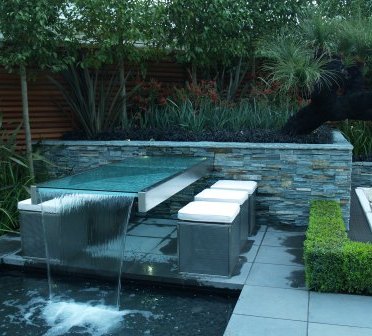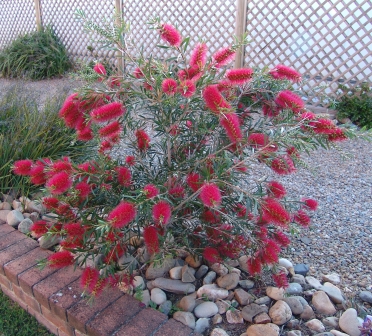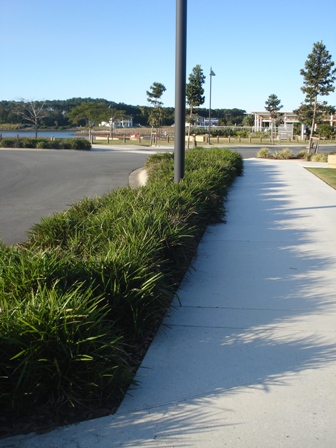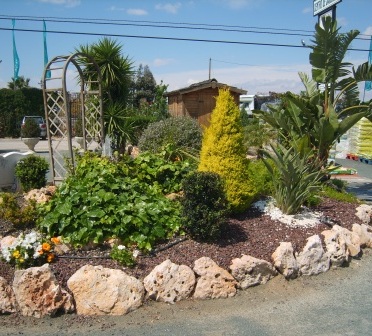
 |
|||
| Sponsors websites: | |||
Plants in Rock and Concrete - QLD.By Todd Layt Plants that perform and look good with rock and hard landscaped areas Rock can make a landscape, or it can break it. Sure almost always it can be the star attraction, adding style and interest in abundance. It can however have a negative impact on the plants around it. So when planting near rock, and hard surfaces, the correct preparation and maintenance, and appropriate plant selection is vital. Sandstone, granite, quartz, luck stones, marble, boulders, bush rock, and even pavers all look great, and should be always used if desired, but when they are used keep in mind that the area around them can get very very hot in summer. So to allow for this either leave extra space for the ground and air to cool, meaning a much larger planting space, use mulch around the plant in these larger spaces, or use tough plants that can cope with the heat from the rocks. Many rock garden designs and plant selection lists have come from cooler climates, but they do not work for long in our harsh Australian sun. Before contemplating the best plant types for a rock garden, the design aspects must first be pondered upon. Sloping terrain can greatly benefit from the use of larger rocks. They not only stabilise the site, they provide a base for smaller rocks to be placed around, and can create the design template for the garden. Outcrops can also be made, by placing a collection of rocks to make higher focal points. Larger rocks, with interesting shapes can capture attention, creating focal points. Series of rock placements, can even act as types of retaining walls, allowing for slopes to be tamed, providing flatter areas for lawns or paths. Not all rock gardens have to be on slopes. Flat ground can also benefit from strategic placement of rocks. Rocks can be used to provide height to some flat ground gardens. Another favorite is the dry river bed look, where, lucky stones are strategically placed to look like a river bed. A large area can be left through the centre, and can even provide a pebbled driveway. Flat rocks can be used to provide open spaces in a garden design, providing the multi-purpose roll of weed suppression, or a place to step and walk through. Pavers and even concrete can be used for pathways, and are often used for open spaces. Often gaps are left for plants. These smaller planting areas can get quite hot, as the Australian sun bounces of these hard surfaces. Roadsides can also be hot harsh places for plants to survive. Cities often create what is known as an urban heat island, with the hard surfaces, making the urban area significantly hotter than the surrounding areas. The EPA says: “On hot summer days, urban air can be 2-6°C hotter than the surrounding countryside.” Your rock garden, pavers or concrete can do even worse to plants in summer. A 42°C day can have a heat effect on the plants that are touching the rock, equivalent to 50°C. Last year I stuck a thermometer near plants in a rock garden and found exactly that. Apart from using plants that can cope with these conditions, there are other things you can do. Firstly, unless the plants are really tough, which there are some; avoid planting rock gardens in summer. Larger holes can be left between the rocks, deeper digging will allow better root establishment, and chunky mulch around the plants will help cool them. Shading is another great tool that will reduce hard surface heat stress. Planting a few shade trees, or mass planting lower growing plants close together will help. The vegetation itself will cool the rock when the gaps are kept to a minimum. Good deep watering will also help, but this is hard to do with water restrictions, so it is better to choose tougher plants. Each Spring, rock gardens, or heated roadside plantings, should have a wetting agent applied, which will help eliminate one of the most common symptoms of this heated dry environment, namely dry patch. Soils in this environment easily become hydrophobic. Compact soils should also be avoided. Mixing in well composted recycled organics, can help plants survive the extra heat from the adjacent rock and hard surfaces. Make sure the drainage is adequate in places where water will flow from the hard surfaces into the soils in volume, or use plants that can cope with periodic wet feet in those areas; for example; places like gullies next to roads. If you really want to use less robust plants in a rock garden, try using the artificial rocks, which today look very real, and are hard to tell apart from the real thing. Choice of Plants Australia is often a sun burnt rocky country, so we have a great choice when it comes to native plants that can cope with this situation. Some of the best can even be planted in summer in these rock or hard surface gardens. Native Shrubs Small Shrubs Large Shrubs Trees Ground Covers Native Grasses Strappy Leaf Plants Some rock gardens may have poor drainage, or plants grown near some paths or roads may have a lot of water running off the concrete on to them, or they maybe excessively irrigated. If this is the case, the plants may have to handle long periods of wet feet. Lomandra hystrix is one of the best plants that can tolerate wet feet, or dry conditions, but up until now, they were very large plants. A new compact variety called Tropicbelle, has made this plant far more usable in the general landscape. Another larger type, called Katie Belles, has magnificent yellow flowers. Many rock gardens or areas adjacent to hot concrete are on slopes, and need the soil stabilised. Newly released King Alfred Dianella caerulea ‘John 316’, which easily handles the heat has recently been shown in scientific tests, to strengthen the soil more than any other tested plant. In the test it strengthen the soil an amazing 752%, compared to common Dianella caerulea which only strengthened the soil 94%. Its blue foliage provides it with highly ornamental qualities ideal for beautiful rock gardens. Another Dianella that works well in rock gardens is Little Jess that has an amazing number of deep purple flowers, and has very tight above ground growing points, that not only are tidy, but allow it to grow and thrive in very trying conditions, including highly diseased soils, extreme tropical conditions, and hot rock gardens. Exotics Ground Covers Shrubs Trees Strappy leaf plants Turf Varieties When using rock, pavers, or concrete in landscape design and construction, it is important to plan for the consequences of increased heat, and other possible associated problems. With a little effort, only good things will come from using rock or hard surfaces next to plants and turf. |
|||||
 |
|||||
 |
|||||
 |
|||||
 |
|||||
 |
|||||
 |
|||||